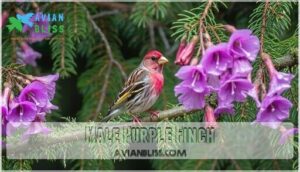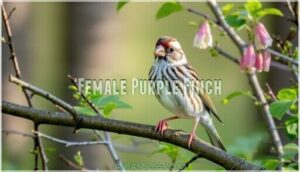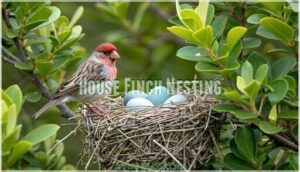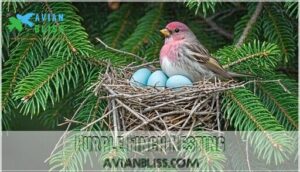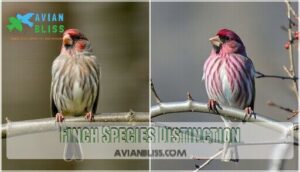This site is supported by our readers. We may earn a commission, at no cost to you, if you purchase through links.
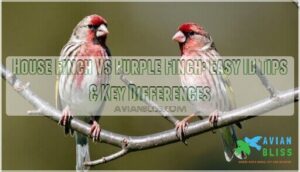
House finch males show red only on their forehead, chest, and rump, while purple finch males display extensive rosy-red covering their head, back, and underparts.
Female identification proves trickier since both species wear streaky brown patterns. However, purple finch females have bolder facial stripes and a more pronounced eyebrow compared to house finches’ subtler markings.
Bill shape also differs – house finches sport slightly curved bills while purple finches have straighter, more conical beaks.
Purple finches prefer wilder habitats and show more erratic movement patterns at feeders. These field marks become second nature once you know exactly where to look.
Table Of Contents
- Key Takeaways
- House Finch Identification
- Finch Plumage Comparison
- Behavioral Differences
- Habitat and Diet
- Finch Species Distinction
- Frequently Asked Questions (FAQs)
- How to identify House Finch?
- What’s the difference between a House Finch and a Purple Finch?
- How rare is a Purple Finch?
- How do you identify a House Finch?
- Do House Finches have red on their back?
- Do house finches and purple finches interbreed?
- Which species is more resistant to diseases?
- How do their migration patterns differ?
- Are there differences in their lifespan?
- Do they have different predators or threats?
- Conclusion
Key Takeaways
- You’ll spot male differences through red distribution – House finch males show red only on their forehead, chest, and rump, while purple finch males display extensive rosy-red covering their entire head, back, and underparts.
- Female identification requires checking facial patterns – Purple finch females have bold white eyebrows and crisp breast streaking, while house finch females show plain brown faces with blurry, muted markings.
- Bill shapes differ between species – House finches sport slightly curved bills designed for cracking seeds, while purple finches have straighter, more conical beaks that appear bulkier.
- Habitat preferences help with identification – House finches thrive in urban backyards and suburban areas year-round, while purple finches prefer wilder forest edges and show seasonal migration patterns.
House Finch Identification
You’ll often spot House Finches at backyard feeders, where their streaky brown plumage and notched tails make them easy to recognize among common feeder birds.
These adaptable finches have expanded their range dramatically over the past century, creating identification challenges with their purple finch cousins in overlapping territories, which can be a challenge due to their similar appearance, but the House Finches are recognizable by their streaky brown plumage.
Size and Population
House finches dominate North American finch populations with their impressive numbers and adaptability.
You’ll encounter these birds far more frequently than their purple cousins, making finch comparison easier through sheer exposure.
Population Trends:
- House finch populations reach 40 million individuals across North America
- Purple finch numbers hover around 6 million birds continent-wide
- Species density favors house finches by nearly 7:1 ratios
This dramatic difference in bird counts reflects house finches’ superior adaptability to human-modified landscapes.
Understanding finch identification is essential for an accurate count of these species.
Range and Distribution
You’ll find these species across dramatically different geographic ranges.
House finches thrive throughout most of North America, from southern Canada to Mexico, with year-round populations in urban and suburban areas.
Purple finches follow distinct migration patterns, breeding in northern coniferous forests and wintering in southern regions.
Their habitat zones rarely overlap, making range a reliable identification tool for distinguishing these finch species in your backyard.
Plumage and Markings
Looking closely at a House Finch reveals distinct feather patterns that separate it from similar species.
Males display streaky brown wing bars with reddish head markings concentrated around the forehead and breast. Their beak color ranges from pale yellow to horn-colored.
Female finch characteristics include heavily streaked tail feathers and subtle wing bars, making bird species identification challenging without careful observation of these specific finch identification markers.
Understanding the goldfinch migration patterns can also aid in distinguishing between finch species during different seasons.
Finch Plumage Comparison
You’ll notice distinct plumage patterns that make identifying male and female house finches versus purple finches much easier once you know what to look for.
The key differences lie in the intensity and distribution of colors, along with specific markings that act as reliable field marks for each species, which help in identifying the key differences.
Male House Finch
Male house finches showcase distinctive red coloration on their forehead, eyebrow, throat, and upper breast.
You’ll notice their brown back and streaked flanks create sharp contrast with bright red areas.
Beak color remains dark, while feather patterns show clear separation between red and brown zones.
| Feature | Male House Finch | Male Purple Finch |
|---|---|---|
| Red Coverage | Forehead, throat, breast only | Entire head and back |
| Streaking | Heavy side streaking | Minimal streaking |
| Back Color | Brown with no red | Reddish-brown wash |
| Beak Shape | Large, conical | Smaller, curved |
The red intensity depends on diet – carotenoid-rich foods produce bolder hues.
During male mating displays, these vibrant colors signal health to potential partners.
Their finch songs accompany courtship flights, making identification easier.
Unlike purple finches, house finch habitat includes urban areas where you’ll spot their brown-and-red plumage year-round.
House finches engage in seed feeding habits that influence their overall health and coloration.
Female House Finch
Unlike their vibrant males, female House Finches sport understated brown plumage with subtle streaking.
You’ll spot them through careful observation of their plain facial features and compact beaks.
These adaptable birds excel at feather care and demonstrate remarkable nesting habits across diverse habitats during finch breeding season.
| Feature | Female House Finch |
|---|---|
| Overall Color | Brown with warm undertones |
| Streaking Pattern | Fine, blurred breast streaks |
| Facial Markings | Plain, no distinct eyebrow |
| Beak Shape | Short, conical seed-cracking design |
| Size Comparison | Smaller, more compact build |
Male Purple Finch
You’ll recognize male Purple Finches by their rich raspberry-red coloring that’s deeper than House Finches.
Their purple feathers create stunning plumage patterns during finch breeding season.
These birds show distinctive finch migration behaviors, traveling between purple finch habitat areas seasonally.
Understanding the purple finch characteristics is essential for accurate identification.
| Feature | Male Purple Finch |
|---|---|
| Head Color | Deep raspberry-red crown |
| Body Tone | Rich purplish-red wash |
| Wing Bars | Two distinct white bars |
| Bill Shape | Thick, conical seed-cracking bill |
Their finch songs include warbling melodies that differ markedly from House Finch vocalizations.
Bird behavior studies show Purple Finches prefer coniferous forests for nesting.
During bird species comparison, notice their stockier build and more intense coloration compared to their House Finch cousins.
Female Purple Finch
Female Purple Finches display crisp white underparts with bold brown stripes that create striking contrast.
Their faces feature prominent white eyebrows above dark eye lines, giving them a masked appearance.
These subtle field marks help distinguish them from their House Finch cousins during finch migration seasons.
| Feature | Female Purple Finch | Female House Finch |
|---|---|---|
| Facial Pattern | White eyebrow, dark eye line | Plain brown face |
| Underparts | White with crisp stripes | Buff with blurry streaks |
| Overall Contrast | High contrast markings | Muted, washed-out appearance |
Behavioral Differences
Once you know what to look for, house finches and purple finches behave quite differently in the field.
House finches are social year-round and often feed in flocks, while purple finches tend to be more solitary except during breeding season.
House Finch Behavior
House finches adapt readily to urban environments, displaying remarkable flexibility in their bird behavior and social interactions.
You’ll notice their confident approach to backyard feeders and comfortable proximity to human activity.
Key House Finch Behavioral Traits:
- Flock Behavior: Form loose, chattering groups year-round
- Foraging Strategies: Ground-feed beneath feeders, often in mixed flocks
- Nesting Patterns: Build nests in shrubs, ledges, and man-made structures
- Mating Habits: Males court females with wing-quivering displays
- Social Interactions: Tolerate close contact while feeding together
Their adaptable finch diet and flexible house finch habitat preferences make them excellent subjects for bird watching and bird species identification practice.
Purple Finch Behavior
Beyond casual backyard encounters, Purple Finches display distinctly different social interactions compared to House Finches.
You’ll notice their more nomadic foraging habits, especially during winter months when they follow food sources across regions. Their territoriality peaks during mating rituals, with males establishing prominent singing perches.
Flight patterns show undulating movements typical of finch species, though Purple Finches maintain tighter flock formations during migration periods.
| Behavior Aspect | Purple Finch Traits | Observation Tips |
|---|---|---|
| Social Structure | Forms loose flocks; less aggressive than House Finches | Watch for peaceful feeding groups |
| Foraging Style | Methodical seed extraction; prefers conifer cones | Look for careful, deliberate movements |
| Territory Defense | Males sing from treetops; less residential than House Finches | Notice high perch preferences |
| Seasonal Movement | Irregular migrations following food availability | Track winter appearance patterns |
Vocalization Patterns
Distinctive finch songs serve as acoustic fingerprints for bird identification.
House Finches produce jumbled, raspy warbles lasting three seconds, often ending with buzzy notes.
Purple Finches deliver smoother, melodious songs with slurred whistles and high-pitched endings.
Song complexity varies regionally, with urban House Finches adjusting call frequency to overcome noise.
Both species demonstrate vocal learning abilities, though Purple Finches excel at mimicry.
Habitat and Diet
You’ll notice these finches choose remarkably different places to call home, with house finches thriving in urban backyards while purple finches prefer wilder forest edges.
Their food preferences also tell a story—house finches crack open seeds at your feeder with gusto, but purple finches have a more refined palate for tree buds and berries.
House Finch Nesting
Seeking the perfect nesting spot, house finches show remarkable adaptability in their nest placement choices.
You’ll find these resourceful backyard birds constructing homes in dense shrubs, building eaves, hanging baskets, and even traffic lights.
Their nesting habits include building cup-shaped structures from twigs, grasses, and debris.
Breeding seasons typically span March through August, with females laying 3-6 pale blue finch eggs per clutch.
Understanding their unique finch social behaviors is essential for appreciating their adaptability in various environments.
Purple Finch Nesting
During breeding season, Purple Finches select elevated nest placement in coniferous trees, typically 15-60 feet high.
Their nesting habits differ substantially from House Finches:
- Nest Placement: Horizontal branches of spruces, firs, or pines
- Breeding Season: April through July in northern ranges
- Finch Eggs: 3-5 pale blue eggs with dark speckles
- Fledgling Care: Parents feed nestlings for 12-14 days
- Territory: Males defend nesting areas through song displays
These bird nesting preferences help distinguish Purple Finches in bird species guides and support bird conservation efforts.
Understanding proper Finch Nesting is vital for creating an ideal environment for these birds.
Food Sources
Both finches share similar seed preferences but differ in their foraging strategies.
House Finches thrive on black oil sunflower seeds and urban weed seeds, while Purple Finches prefer smaller tree seeds and forest fruits.
Their bird feeding habits reveal distinct bird ecology patterns that help with bird comparison.
Understanding the role of sunflower bird seeds is essential in maintaining a balanced ecosystem for these finches.
| Food Type | House Finch | Purple Finch |
|---|---|---|
| Seed Preferences | Weed seeds, sunflower | Tree seeds, nyjer |
| Fruit Consumption | Cultivated fruits | Wild berries, tree fruits |
| Insect Eating | Minimal (3% diet) | Seasonal supplement |
Finch Species Distinction
You’ll quickly master the art of separating house finches from purple finches once you know the key field marks that distinguish these common backyard visitors.
The secret lies in focusing on specific details like bill shape, head patterns, and the extent of streaking rather than relying solely on color differences.
House Finch Vs Purple Finch
Side-by-side bird comparison reveals key differences you’ll spot in the field.
Male house finches show orange-red coloring on head and breast, while purple finches display deeper raspberry-red wash across entire body.
Beak shapes differ noticeably – house finches have curved bills, purple finches sport straighter, conical beaks.
These bird characteristics help distinguish finch pairs during bird feeding sessions.
Female House Finch Vs Female Purple Finch
Distinguishing female finches requires sharp observation since both lack the males’ vibrant coloration.
Female Purple Finches display bold facial patterns that serve as reliable bird field marks for identification.
- Facial markings: Purple Finch shows distinct white eyebrow stripe and dark cheek patch
- Breast streaking: House Finch has blurry streaks; Purple Finch features crisp, defined lines
- Beak shape: Purple Finch bill appears bulkier for cracking larger seeds
Understanding the unique characteristics of each species, such as their seed eating habits, can aid in accurate identification and appreciation of these birds.
ID Challenge Solutions
When you’re stumped by tricky finches, modern Finch ID Tips through Birding Apps can save the day.
Use bird identification guides for detailed Feather Analysis comparing Beak Shapes and Wing Patterns.
Digital bird identification tools offer instant species comparisons, while bird identification platforms provide expert insights.
These bird species resources and analysis tools turn challenging identifications into confident field experiences with bird identification guides.
Frequently Asked Questions (FAQs)
How to identify House Finch?
Like spotting a familiar face in a crowd, you’ll recognize House Finches by their curved beaks, streaky brown plumage, and males’ raspberry-red wash on head and chest.
They’re stockier than Purple Finches with less distinct streaking, which helps in distinguishing them.
What’s the difference between a House Finch and a Purple Finch?
House Finches show brownish streaking with males having red foreheads and breasts.
Purple Finches display more uniform coloring—males appear raspberry-red overall while females have distinct white eyebrows and cleaner facial patterns.
How rare is a Purple Finch?
Purple Finches aren’t rare but face gradual declines due to competition from House Finches.
They’re common in northern regions and Pacific coast areas, but very rare in Rocky Mountain territories.
You’ll spot them more easily at winter feeders than during breeding season.
How do you identify a House Finch?
Look for the male’s rosy-red head and breast with brown streaking on flanks.
Females show brown streaking throughout with subtle reddish tinges.
Note the slightly curved upper mandible and compact build compared to other finches.
Do House Finches have red on their back?
Male House Finches don’t have red on their backs. You’ll only spot red coloring on their heads, throats, and chest areas. Their backs stay brown with darker streaking patterns throughout.
Do house finches and purple finches interbreed?
Hybridization between these closely related finch species occurs occasionally in the wild, though it’s uncommon.
You’ll typically find pure populations, but where ranges overlap, mixed pairs can produce fertile offspring with intermediate characteristics, and this is a result of hybridization.
Which species is more resistant to diseases?
Absolutely crushing the competition, purple finches appear naturally resistant to mycoplasmal conjunctivitis infections that primarily affect house finches.
You’ll find purple finches demonstrate stronger immune systems and better disease resistance overall.
How do their migration patterns differ?
House finches typically stay put year-round, while purple finches migrate seasonally from northern breeding grounds to southern wintering areas.
You’ll spot purple finches moving hundreds of miles, but house finches remain local residents.
Are there differences in their lifespan?
You’ll find house finches typically live 4-6 years in the wild, while purple finches average 7-10 years.
Purple finches’ longer lifespan relates to their hardier nature and less urbanized lifestyle compared to house finches.
Do they have different predators or threats?
After relocating from California to Colorado, you might notice hawks targeting house finches more aggressively than purple finches due to habitat preferences.
Both species face similar predators—hawks, cats, and snakes—but purple finches’ forest dwelling provides better cover than house finches’ open suburban exposure, which makes them more susceptible to predators.
Conclusion
Birders everywhere can relate to this scenario: you confidently announce "house finch!" only to have a seasoned birder politely correct your identification.
Don’t let finch confusion ruffle your feathers anymore. With practice, distinguishing house finch vs purple finch becomes straightforward once you focus on key field marks.
Remember that males show the clearest differences in red coloration patterns, while females require attention to facial markings and bill shape.
These identification skills will serve you well at feeders and in the field.
- https://coleswildbird.com/how-do-you-tell-a-house-finch-from-a-purple-finch/
- https://dnr.illinois.gov/education/wildaboutpages/wildaboutbirds/wildaboutbirdswaxwings/wabpurplefinch.html
- https://www.youtube.com/watch?v=0HeZTYewqyg
- https://www.birdforum.net/threads/how-to-identify-a-purple-vs-house-finch.406489/
- https://www.allaboutbirds.org/guide/House_Finch/species-compare/



